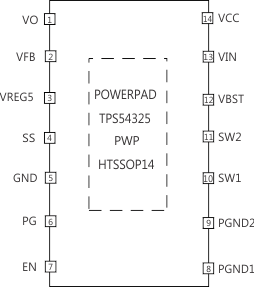JAJSOP7A June 2011 – July 2022 TPS54325-Q1
PRODUCTION DATA
- 1 特長
- 2 アプリケーション
- 3 概要
- 4 Revision History
- 5 Pin Configuration and Functions
- 6 Specifications
- 7 Detailed Description
- 8 Application and Implementation
- 9 Power Supply Recommendations
- 10Layout
- 11Device and Documentation Support
- 12Mechanical, Packaging, and Orderable Information
パッケージ・オプション
メカニカル・データ(パッケージ|ピン)
- PWP|14
サーマルパッド・メカニカル・データ
- PWP|14
発注情報
5 Pin Configuration and Functions
 Figure 5-1 14-Pin PWP HTSSOP Pinout
Figure 5-1 14-Pin PWP HTSSOP PinoutTable 5-1 Pin Functions
| Pin | Description | |
|---|---|---|
| Name | NO. | |
| VO | 1 | Connect this pin to the output of the converter. This pin is used for on-time adjustment. |
| VFB | 2 | Converter feedback input. Connect this pin with a feedback resistor divider. |
| VREG5 | 3 | 5.5-V power supply output. Connect a capacitor (typically 1μF) to GND. |
| SS | 4 | Soft-start control. Connect an external capacitor to GND. |
| GND | 5 | Signal ground pin |
| PG | 6 | Open-drain power-good output |
| EN | 7 | Enable control input |
| PGND1, PGND2 | 8, 9 | Ground returns for low-side MOSFET. These ground returns also serve as inputs of current comparators. Connect PGND and GND strongly together near the IC. |
| SW1, SW2 | 10, 11 | Switch node connections between the high-side NFET and low-side NFET. These connections also serve as inputs to current comparators. |
| VBST | 12 | Supply input for high-side NFET gate driver (boost terminal). Connect a capacitor from this pin to respective SW1 and SW2 terminals. An internal PN diode is connected between VREG5 to VBST pin. |
| VIN | 13 | Power input and connected to high-side NFET drain |
| VCC | 14 | Supply input for the 5-V internal linear regulator for the control circuitry |
| PowerPAD | Back side | Thermal pad of the package. Must be soldered to achieve appropriate dissipation. Connect to GND. |